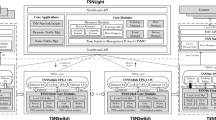Abstract
Network layer multicast is a highly efficient one-to-many transmission mode. Data rates supported by different group members may differ if these members are located in different network environments. Currently there are roughly two types of methods solving the problem, one is limiting the data rate so that every group member can sustain transmissions, and the other is building multiple trees to increase the provision of network bandwidth. The former is inefficient in bandwidth usage, and the latter adds too many states in the network, which is a serious problem in Software-Defined Networks. In this paper, we propose to build localized extra path(s) for each bottleneck link in the tree. By providing extra bandwidth to reinforce the bottleneck links, the overall data rate is increased. As extra paths are only built in small areas around the bottleneck links, the number of states added in the network is restrained to be as small as possible. Experiments on Mininet verify the effectiveness of our solution.
Similar content being viewed by others
References
Barán B, Fabregat R, Donoso Y, Solano F, Marzo J. Generalized multiobjective multitree model. WSEAS Journal, 2004
Rückert J, Blendin J, Hark R, Hausheer D. DYNSDM: dynamic and flexible software-defined multicast for ISP environments. In: Proceedings of the 11th International Conference on Network and Service Management. 2015, 117–125
Tang S, Hua B, Wang D. Realizing video streaming multicast over SDN. In: Proceedings of the 9th International Conference on Communications and Networking in China. 2014
Jiang T, Ammar M, Zegura E W. On the use of destination set grouping to improve inter-receiver fairness for multicast ABR sessions. In: Proceedings of IEEE INFOCOM. 2000
Yang Y R, Kim M S, Lam S S. Optimal partitioning of multicast receivers. In: Proceedings of IEEE International Conference on Network Protocols. 2000
McCanne S, Jacobson V, Vetterli M. Receiver-driven layered multicast. ACM SIGCOMM Computer Communication Review, 1996, 26(4): 117–130
Shacham N. Multipoint communication by hierarchically encoded data. In: Proceedings of the 11th Annual Joint Conference of the IEEE Computer and Communications Societies. 1992, 2107–2114
Barán B, Fabregat Gesa R, DonosoMeisel Y, Solano Donado F, Marzoi Lázaro J. Generalized multiobjective multitree model solution using MOEA. In: Proceedings of the 6th International Conference on Wseas International Conference on Evolutionary Computing. 2005, 263–268
Nagata A, Tsukiji Y, Tsuru M. Delivering A File by Multipath-Multicast on OpenFlow networks. In: Proceedings of the 5th International Conference on Intelligent Networking and Collaborative Systems. 2013, 835–840
Acknowledgements
This work was supported by the Strategic Priority Research Program of the Chinese Academy of Sciences (XDA06011201), and Jiangsu Future Networks Innovation Institute for Prospective Research Project on Future Networks (BY2013095).
Author information
Authors and Affiliations
Corresponding author
Additional information
Siyuan Tang earned her bachelor’s degree in computer science from the University of Science and Technology of China (USTC), China in 2010. From 2010, she continued her study in computer science in USTC as a PhD student. Her research focuses on the highly efficiency multicast transmission in software-defined networking.
Bei Hua is a professor in the School of Computer Science and Technology at University of Science and Technology of China (USTC), China. She received her PhD degree in computer science from USTC in 2005. Her research interests include multicore computing and system optimization, network function virtualization, and software-defined networking.
Electronic supplementary material
Rights and permissions
About this article
Cite this article
Tang, S., Hua, B. Increasing multicast transmission rate with localized multipath in software-defined networks. Front. Comput. Sci. 13, 413–425 (2019). https://doi.org/10.1007/s11704-017-6415-z
Received:
Accepted:
Published:
Issue Date:
DOI: https://doi.org/10.1007/s11704-017-6415-z




